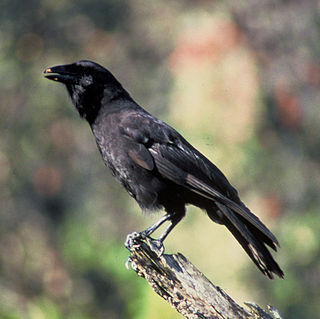
The Hawaiian crow or ʻalalā is a species of bird in the crow family, Corvidae, that is currently extinct in the wild, though reintroduction programs are underway. It is about the size of the carrion crow at 48–50 cm (19–20 in) in length, but with more rounded wings and a much thicker bill. It has soft, brownish-black plumage and long, bristly throat feathers; the feet, legs, and bill are black. Today, the Hawaiian crow is considered the most endangered of the family Corvidae. They are recorded to have lived up to 18 years in the wild, and 28 years in captivity. Some Native Hawaiians consider the Hawaiian crow an ʻaumakua.

Eudonia is a large and widespread genus in the grass moth family (Crambidae), subfamily Scopariinae. There is no common name for the roughly 250 species placed here; new species are still being described regularly. Although the genus was proposed early in the 19th century, many of these moths were for a long time retained in Scoparia, the type genus of the subfamily and a close relative of Eudonia. A few small genera have been proposed for separation from Eudonia, but given the size of this group this is not particularly convincing; thus, all are retained here pending a comprehensive phylogenetic review.
Eudonia balanopis is a moth of the family Crambidae. It is endemic to the Hawaiian islands of Oahu, Molokai and Hawaii.
Eudonia bucolica is a moth of the family Crambidae. It is endemic to the Hawaiian islands of Oahu, Molokai, Maui and Hawaii.
Eudonia dactyliopa is a moth of the family Crambidae. It is endemic to the Hawaiian islands of Oahu and Molokai. The larvae feed on moss.
Eudonia formosa is a moth of the family Crambidae. It is endemic to the Hawaiian islands of Oahu and Maui.
Eudonia frigida is a moth of the family Crambidae. It is endemic to the Hawaiian islands of Lanai and Maui.
Eudonia gonodecta is a moth of the family Crambidae. It is endemic to the Hawaiian island of Kauai.
Eudonia halirrhoa is a moth of the family Crambidae. It is endemic to the island of Hawaii.
Eudonia ischnias is a moth of the family Crambidae. It is endemic to the Hawaiian island of Maui.
Eudonia loxocentra is a moth of the family Crambidae. It is endemic to the island of Hawaii.
Eudonia marmarias is a moth of the family Crambidae. It is endemic to the Hawaiian islands of Oahu, Molokai, Maui and Hawaii.
Eudonia melanocephala is a moth of the family Crambidae. It is endemic to the island of Hawaii.
Eudonia meristis is a moth of the family Crambidae. It is endemic to the Hawaiian islands of Oahu, Molokai, Kauai and Hawaii. The larvae feed on moss.
Eudonia ombrodes is a moth of the family Crambidae. It is endemic to the Hawaiian islands of Oahu, Molokai, Maui, Lanai and Hawaii.
Eudonia probolaea is a moth of the family Crambidae. It is endemic to the Hawaiian islands of Kauai and Hawaii. Eudonia omichlopis is considered a valid species by some authors, while others include it within E. probolaea.
Eudonia pachysema is a moth of the family Crambidae. It is endemic to the Hawaiian island of Maui.
Eudonia religiosa is a moth of the family Crambidae. It is endemic to the Hawaiian islands of Oahu and possibly Hawaii.
Eudonia thyellopis is a moth of the family Crambidae. It is endemic to the Hawaiian islands of Kauai, Oahu, Lanai and Hawaii.

